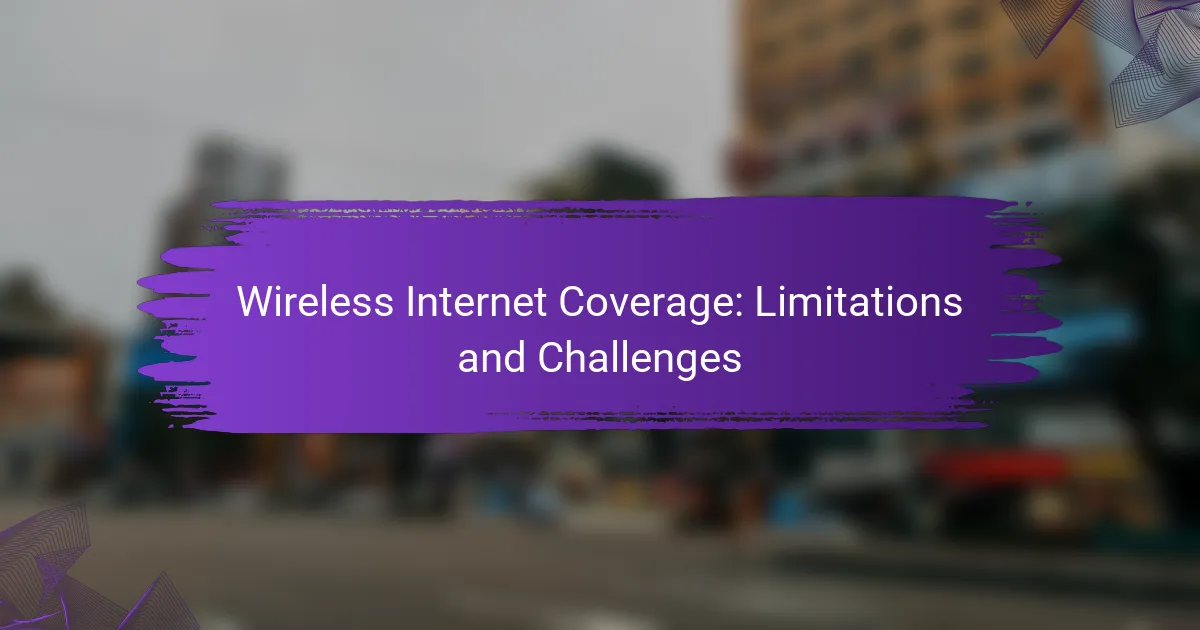Wireless internet coverage faces several limitations and challenges that can impact user experience, particularly in rural areas. Factors such as signal interference, distance from the router, and environmental conditions can hinder connectivity and reliability. Additionally, geographical and economic barriers further complicate access to quality wireless services, especially in less populated regions.

What are the limitations of wireless internet coverage in the UK?
The limitations of wireless internet coverage in the UK include signal interference, limited bandwidth, distance from the router, and environmental factors. These challenges can significantly affect the quality and reliability of internet access for users.
Signal interference from physical obstacles
Wireless signals can be obstructed by physical barriers such as walls, furniture, and appliances. Materials like concrete and metal are particularly effective at blocking signals, leading to weaker connections in certain areas of a home or office.
To mitigate interference, consider placing the router in a central location and away from large objects. Using Wi-Fi extenders or mesh networks can also help improve coverage in hard-to-reach areas.
Limited bandwidth availability
Bandwidth refers to the maximum data transfer rate of an internet connection, and in many cases, it is limited by the service plan. In the UK, users may experience slower speeds during peak times when many people are online simultaneously.
To optimize bandwidth usage, limit the number of devices connected to the network and prioritize activities that require higher speeds, such as streaming or gaming. Upgrading to a higher-tier service plan can also provide more bandwidth for heavy users.
Distance from the router affects speed
The further a device is from the router, the weaker the signal and the slower the internet speed. Typically, Wi-Fi signals can effectively cover distances of around 30 meters indoors, but this can vary based on obstacles and interference.
To maintain optimal speeds, try to keep devices within close proximity to the router. If distance is unavoidable, consider using wired connections or investing in additional access points to extend coverage.
Environmental factors impacting signal
Environmental factors such as weather conditions and electronic devices can impact wireless internet coverage. For instance, heavy rain or thunderstorms can disrupt signals, while microwaves and cordless phones can cause interference.
To minimize these effects, avoid placing the router near electronic devices that may cause interference. Additionally, consider using dual-band routers that operate on both 2.4 GHz and 5 GHz frequencies to reduce the impact of environmental factors on your connection.

How can I improve wireless internet coverage at home?
Improving wireless internet coverage at home involves strategic placement of your router, utilizing technology like extenders or mesh systems, and minimizing interference from other devices. These steps can significantly enhance your Wi-Fi signal strength and reliability throughout your living space.
Position router in a central location
Placing your router in a central location within your home is crucial for maximizing wireless coverage. Ideally, it should be elevated and free from obstructions like walls or furniture that can block signals. Aim for a location that is equidistant from the areas where you most frequently use the internet.
Consider the layout of your home; if you have multiple floors, placing the router on the upper level can help distribute the signal more evenly. Regularly check the signal strength in various rooms to ensure optimal placement.
Use Wi-Fi extenders or mesh systems
Wi-Fi extenders and mesh systems can significantly enhance coverage in larger homes or areas with weak signals. Extenders amplify the existing signal, while mesh systems create a network of interconnected nodes that provide seamless coverage throughout your space.
When choosing between the two, consider the size of your home and the number of devices connected. Mesh systems tend to offer better performance in larger areas, while extenders are a cost-effective solution for smaller spaces.
Reduce interference from other devices
Interference from other electronic devices can disrupt your wireless internet coverage. Common culprits include microwaves, cordless phones, and Bluetooth devices. To minimize this interference, keep your router away from these devices and consider switching to a less crowded Wi-Fi channel.
Additionally, using the 5 GHz band instead of the 2.4 GHz band can help reduce interference, as the 5 GHz band typically experiences less congestion. Regularly check for firmware updates for your router, as these can improve performance and reduce interference issues.

What are the challenges of rural wireless internet access in the UK?
The challenges of rural wireless internet access in the UK primarily stem from geographical and economic factors. Low population density, high infrastructure costs, and limited provider options hinder the development and availability of reliable wireless services in these areas.
Low population density affecting service
Rural areas in the UK often have a low population density, which makes it less economically viable for internet service providers (ISPs) to invest in infrastructure. With fewer potential customers, the return on investment for building and maintaining wireless networks diminishes.
This low density can lead to slower internet speeds and less reliable connections, as the infrastructure may not be robust enough to support the limited number of users effectively. Residents may experience higher latency and lower bandwidth, making activities like streaming or online gaming challenging.
Higher installation costs for infrastructure
The installation costs for wireless internet infrastructure in rural areas are typically higher than in urban settings. Factors such as the need for extensive cabling, the installation of towers, and the geographical challenges posed by hills or forests contribute to these elevated costs.
In many cases, these expenses are passed on to consumers, leading to higher subscription fees. Additionally, the upfront investment required can deter new providers from entering the market, further limiting options for rural residents.
Limited provider options in remote areas
In remote areas of the UK, there are often few ISPs available, which reduces competition and can lead to higher prices and lower service quality. Many rural communities find themselves reliant on a single provider, limiting their choices and bargaining power.
This lack of competition can result in outdated technology being used, as providers may not feel pressured to upgrade their services. Residents may have to settle for slower speeds and less reliable connections, which can impact their daily lives and work-from-home capabilities.

What factors affect wireless internet speed?
Wireless internet speed is influenced by several key factors, including the technology of the router, network congestion, and the number of devices connected. Understanding these elements can help optimize your internet experience.
Router specifications and technology
The specifications and technology of your router play a crucial role in determining wireless internet speed. Modern routers that support Wi-Fi 5 (802.11ac) or Wi-Fi 6 (802.11ax) generally provide faster speeds and better performance compared to older models.
Consider the frequency bands as well; routers typically operate on 2.4 GHz and 5 GHz bands. The 5 GHz band offers higher speeds but shorter range, while the 2.4 GHz band provides broader coverage but at lower speeds. Choosing the right band for your needs can enhance your internet experience.
Network congestion during peak hours
Network congestion occurs when many users access the internet simultaneously, particularly during peak hours. This can lead to slower speeds as the available bandwidth is shared among multiple users.
To mitigate congestion, consider scheduling high-bandwidth activities like streaming or gaming during off-peak hours. Additionally, using Quality of Service (QoS) settings on your router can prioritize important traffic, helping to maintain speed during busy times.
Number of connected devices
The number of devices connected to your wireless network directly impacts internet speed. Each device consumes a portion of the available bandwidth, which can slow down the connection for all users.
As a rule of thumb, if you have multiple devices streaming video, gaming, or downloading large files, you may experience slower speeds. To optimize performance, limit the number of active devices when possible or upgrade your internet plan to accommodate higher usage.

How does weather impact wireless internet connectivity?
Weather significantly affects wireless internet connectivity, primarily through elements like rain, humidity, and wind. These factors can lead to signal degradation, reduced speeds, and even temporary outages.
Rain and humidity causing signal degradation
Rain and high humidity can absorb and scatter wireless signals, leading to weaker connections. The impact varies based on the frequency of the signal; higher frequencies, such as those used in 5G, are more susceptible to these weather conditions.
For example, during heavy rain, users may experience a drop in internet speed by 20-50%. To mitigate this, consider using lower frequency bands for better reliability in wet conditions.
Wind affecting outdoor antennas
Wind can physically disrupt outdoor antennas, causing misalignment and affecting signal strength. Strong gusts may lead to fluctuations in connectivity, particularly for fixed wireless installations.
To minimize wind-related issues, ensure antennas are securely mounted and regularly checked for alignment. If you live in a windy area, consider using more robust mounting solutions to maintain optimal performance.

What are the best practices for maintaining wireless internet performance?
To maintain optimal wireless internet performance, regularly assess your network setup and implement key practices. These include updating router firmware, optimizing placement, and managing connected devices effectively.
Regularly update router firmware
Updating your router’s firmware is crucial for maintaining wireless internet performance. Firmware updates often include security patches, performance enhancements, and new features that can improve connectivity and speed.
Check your router manufacturer’s website or the router’s admin interface for available updates. Typically, this process involves downloading the latest firmware file and following the installation instructions, which can take just a few minutes.
Neglecting firmware updates can lead to vulnerabilities and performance issues. Aim to check for updates every few months or set your router to update automatically if that option is available.
